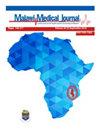Assessment of descending aortic blood flow velocities with continuous wave Doppler echocardiography among healthy Children in South East Nigeria
IF 1.2
4区 医学
Q4 PUBLIC, ENVIRONMENTAL & OCCUPATIONAL HEALTH
引用次数: 0
Abstract
Background The descending aorta velocity is important predictor of aortic disease in children and can be very helpful in some clinical and surgical decision making.Aim The purpose of this study is to assess the normative values of descending aorta velocity among children from South-East Nigeria. It also aimed to assess the correlation between age, body surface area and mean velocity across the descending aorta. Methods This is a cross-sectional study where the descending aorta velocity of one hundred and eleven children were enrolled consecutively using digitized two-dimensional and Doppler echocardiography.ResultsA total of 111 children had echocardiography to study their cardiac structures and compute their mean scores of their descending aorta velocity. The mean velocity across the descending aorta was 1.3±0.2m/s with maximum and minimum velocities of 2.06 and 0.84cm respectively. The mean descending aorta velocity in males (1.37±0.24 m/s) was significantly higher than that in females (1.24±0.18); (Student T test 3.09, p = 0.03). There was no correlation between age and mean velocity across the descending aorta (Pearson correlation coefficient; -0.03, p = 0.7) nor between body surface area and descending aorta velocity (correlation coefficient 0.01, p= 0.8). Conclusions The presented normalized values of the descending aorta velocity using a digitized two-dimensional and Doppler echocardiography among healthy children will serve as a reference values for further studies and can be applied for clinical and surgical use in children with various cardiac anomalies.用连续波多普勒超声心动图评估尼日利亚东南部健康儿童的降主动脉血流速度
背景 降主动脉速度是预测儿童主动脉疾病的重要指标,对一些临床和手术决策非常有帮助。研究还旨在评估年龄、体表面积和降主动脉平均速度之间的相关性。结果 共有 111 名儿童接受了超声心动图检查,以研究他们的心脏结构并计算他们降主动脉速度的平均值。降主动脉的平均速度为 1.3±0.2m/s,最大和最小速度分别为 2.06cm 和 0.84cm。男性降主动脉的平均速度(1.37±0.24 m/s)明显高于女性(1.24±0.18);(学生 T 检验 3.09,P = 0.03)。年龄与降主动脉平均速度之间没有相关性(皮尔逊相关系数;-0.03,P = 0.7),体表面积与降主动脉速度之间也没有相关性(相关系数 0.01,P = 0.8)。结论 在健康儿童中使用数字化二维和多普勒超声心动图得出的降主动脉速度归一化值将作为进一步研究的参考值,并可用于各种心脏畸形儿童的临床和手术治疗。
本文章由计算机程序翻译,如有差异,请以英文原文为准。
求助全文
约1分钟内获得全文
求助全文
来源期刊

Malawi Medical Journal
Medicine-General Medicine
CiteScore
1.50
自引率
0.00%
发文量
27
审稿时长
>12 weeks
期刊介绍:
Driven and guided by the priorities articulated in the Malawi National Health Research Agenda, the Malawi Medical Journal publishes original research, short reports, case reports, viewpoints, insightful editorials and commentaries that are of high quality, informative and applicable to the Malawian and sub-Saharan Africa regions. Our particular interest is to publish evidence-based research that impacts and informs national health policies and medical practice in Malawi and the broader region.
Topics covered in the journal include, but are not limited to:
- Communicable diseases (HIV and AIDS, Malaria, TB, etc.)
- Non-communicable diseases (Cardiovascular diseases, cancer, diabetes, etc.)
- Sexual and Reproductive Health (Adolescent health, education, pregnancy and abortion, STDs and HIV and AIDS, etc.)
- Mental health
- Environmental health
- Nutrition
- Health systems and health policy (Leadership, ethics, and governance)
- Community systems strengthening research
- Injury, trauma, and surgical disorders
 求助内容:
求助内容: 应助结果提醒方式:
应助结果提醒方式:


